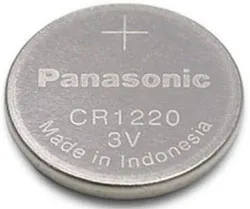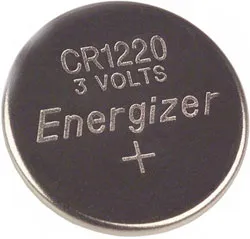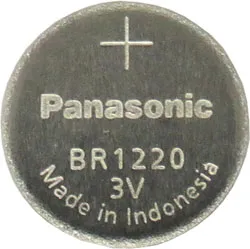The Ultimate Guide to CR1220 Battery
CR1220 battery is a lithium coin cell battery widely used in various devices such as keyless entry, heart rate monitors, blood glucose monitors, toys and games. It has a diameter of 12 mm, a thickness of 2 mm, a nominal voltage of 3 V and a typical capacity of 40 mAh. In this article, we’ll give you the ultimate guide to CR1220 batteries, covering their features, benefits, applications, alternatives, and tips for proper use and storage.
Introduction of the CR1220 Battery
Popular keychain LED torches, thermometers, key-less remote controls, medical scales, PDAs, heart rate monitors, cameras, and other electronic devices all use the CR1220 non-rechargeable lithium 3.0V button/coin cell battery.
As they have the same physical dimensions but a different chemistry, CR1220 batteries are significantly more prevalent than BR1220 battery and have different properties in terms of battery capacity, voltage, operating temperature, self-discharge rate, etc.

CR1220 Battery Features and Specifications
The physical measurements of CR1220 and BR1220 batteries are 12.5 x 2.0 mm (or around 0.4921 x 0.07874 inches).
The most popular labels for lithium 3.0 volts non-rechargeable button/coin cell batteries are BR1220 and CR1220, but other names are also used, such as ECR1220, DL1220, VR1220, 5012LC, etc.
All of these 12.5 x 2.0 mm button/coin cells may have different chemistry, which will affect how they discharge.
Lithium serves as the negative electrode in BR1220 and CR1220 batteries, while carbon monfluoride or manganese dioxide serve as the positive electrode.
In general, the working temperature range of manganese-dioxide lithium batteries is between -20°C (-4°F) and 70°C (158°F). 3.0 V is the nominal value, and 2.0 V is the cutoff voltage.
The CR1220 battery, which has a normal capacity of 35 to 40 mAh, a standard discharge current of 0.05 to 0.1 mA, and a maximum continuous discharge current of 1 mA, is a typical example.
Note: Of course, factors such as discharge current, temperature, battery age, daily pulse rate, and others affect actual capacity.
The shelf life of a CR1220 battery typically ranges from 4 to 7 years depending on its self-discharge rate, while some models have a shelf life of up to 10 years. The best CR1220 batteries have an annual discharge rate at room temperature of less than 1%.

Labels for lithium-carbon-monofluoride batteries begin with the letter "B," therefore the label BR1220. The typical operating range for BR1220 batteries is between -30°C (-22°F) and 85°C (185°F). The cutoff voltage is 2.0 V, and the nominal voltage is 3.0 V. This voltage is very similar to the CR1220 battery. In contrast to CR1220 battery, 'older' BR1220 battery has a nominal voltage of 2.8 volts and a cutoff voltage of about 2.25 volts. Regardless of the precise battery chemistry, BR1220 battery has a more stable output voltage.
The BR1220 battery has a capacity of around 35 mAh, but its standard discharge current is lower than that of CR1220 battery at approximately 0.03, with a maximum continuous discharge current of 0.1 (if permitted).
However, the BR1220 battery has a typical annual discharge rate of less than 1%, ensuring a shelf life of over 10 years. This makes it an ideal choice for devices that require dependable memory backup batteries.

In most situations, BR1220 and CR1220 batteries can be used interchangeably. However, it is important to consider the specific application and conditions in order to make the best choice. For low-drain applications at room temperature, both batteries are suitable. However, for high-drain applications such as keyless LED flashlights and remote controls, CR1220 battery is generally considered to be better choices. On the other hand, if the batteries will be used in extreme temperatures, BR1220 battery may be a more suitable option. It is always recommended to consult the manufacturer's guidelines or seek professional advice when selecting batteries for specific applications.
Are BR1220 and CR1220 batteries interchangeable?
In most situations, BR1220 and CR1220 batteries can be used interchangeably.
However, it is important to consider the specific application and conditions in order to make the best choice. For low-drain applications at room temperature, both batteries are suitable. However, for high-drain applications such as keyless LED flashlights and remote controls, CR1220 battery is generally considered to be better choices. On the other hand, if the batteries will be used in extreme temperatures, BR1220 battery may be a more suitable option. It is always recommended to consult the manufacturer's guidelines or seek professional advice when selecting batteries for specific applications.
CR1220 Security Issues
CR1220 battery comes in so-called "pet-safe" and "child-safe" packaging because, like all similar small, shiny objects (including other button/button batteries), CR1220 battery can be swallowed and ingested by children. Pets, this can be very dangerous.
Although these batteries do not contain lead, cadmium, mercury and other toxic heavy metals and similar contaminants, they are very dangerous when swallowed - they can cause chemical burns and physical damage to internal organs.
If these batteries (or any similar batteries) are swallowed, contact the nearest emergency center (or doctor) immediately, explain what has happened, and follow their instructions.
Benefits of CR1220 battery
This section will highlight the advantages of using CR1220 battery in various devices, such as its high energy density, long-lasting performance, low self-discharge rate, wide temperature range, leak-resistant design, and environmental friendliness. It will also provide some examples of how CR1220 battery can enhance the functionality and reliability of different devices.
Applications of CR1220 battery
This section will list some of the common devices that use CR1220 battery as their power source, such as keyless entry systems, heart-rate monitors, glucose monitors, LED lights, bracelets, flashlights, watches, calculators, coin counters, and more. It will also provide some tips on how to choose the right CR1220 battery for your device based on its specifications and requirements.
Tips for proper use and storage of CR1220 battery
This section will provide some useful advice on how to use and store CR1220 battery safely and efficiently. It will cover topics such as how to insert and remove CR1220 battery from your device correctly, how to avoid short-circuiting or overheating your CR1220 battery, how to dispose of your used or expired CR1220 battery properly, and how to store your unused or spare CR1220 battery in a cool and dry place away from direct sunlight or heat sources.
Frequently Asked Questions
Q1 How long does a CR1220 battery last?
CR1220 batteries usually last around 2-3 years, depending on usage. However, actual battery life may vary depending on factors such as device used, frequency of use, and operating temperature. It's worth noting that battery drain may be noticeable if the device is left on for an extended period of time or exposed to high temperatures.
Q2 What is the voltage of a CR1220 battery?
CR1220 batteries typically have a voltage of 3 volts.
Q3 Can a CR1220 battery be recharged?
No, the CR1220 battery cannot be charged because it is a primary (non-rechargeable) battery. Attempting to recharge can cause leaks or even explosions, so it's important to dispose of used batteries correctly and use new replacement batteries when needed.
Q4 How do I dispose of a used CR1220 battery safely?
To safely dispose of used CR1220 batteries, you should not throw them into the regular trash. Instead, you can recycle it at your local recycling center or collection point that accepts batteries. Professionals also offers recycling programs for batteries. Proper disposal of batteries is important to protect the environment and prevent potential harm to human health.
Bottom line
The CR1220 is a very popular 12.5 x 2.0 mm lithium, non-rechargeable 3.0 volt battery. They're easy to find, just make sure you order batteries from a reputable brand with lots of positive reviews - their batteries have been tested in real life by countless users.
CR1225 Battery: Applications, Features and Specifications
CR2 3V Battery: Applications, Features, and Equivalent
LR44H Battery: Application, Features, and Equivalent
H7 AGM Battery: Applications, Features and Equivalent
94RH7 Battery: Applications, Features, and Equivalent
Nickel-Cadmium Battery : Principle & Its Applications
LR44 Battery Equivalent: Applications and Features
94RH7 Battery: Applications and Features
Different Types of Battery Chargers: How Do They Differ?
CR1616 vs CR2025 Battery










